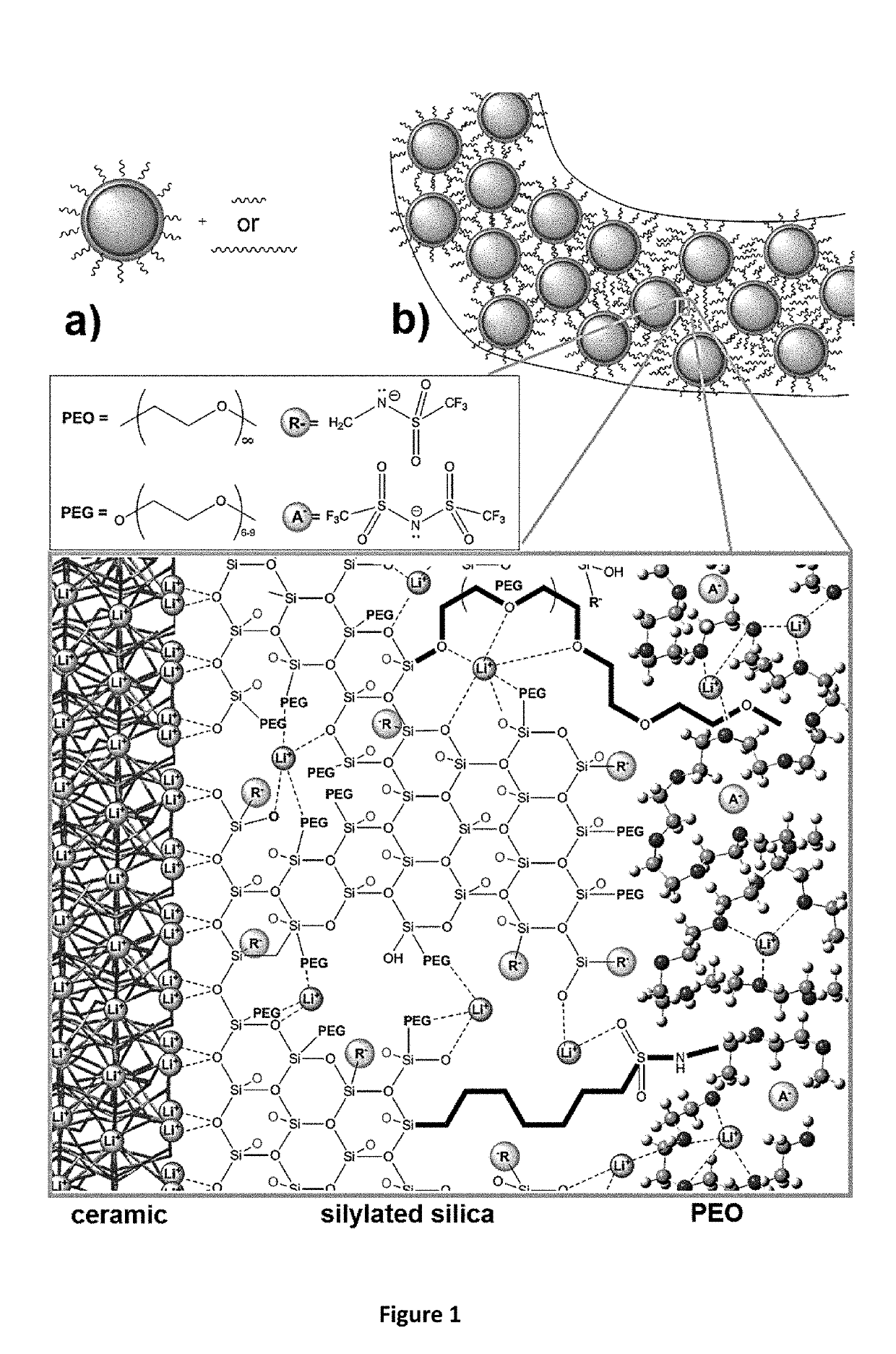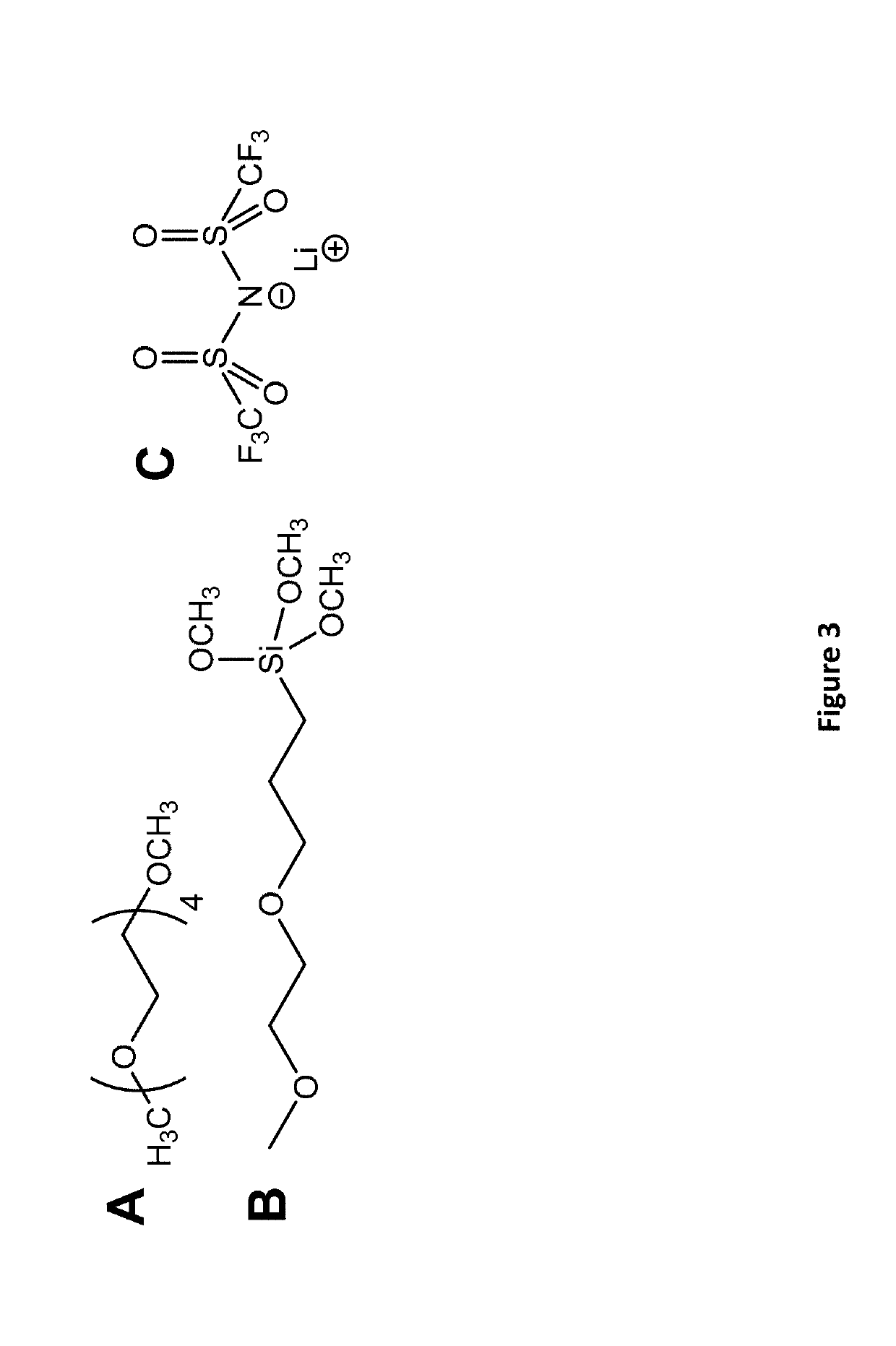Silanated Silica-Ceramic Materials, and Methods of Making and Using the Same
a technology of silica-ceramic materials and silica-ceramic materials, which is applied in the direction of cell components, cell component details, electrochemical generators, etc., can solve the problems of physical and electrochemical problems, severe damage, injury or death, poor adhesion to or compatibility with lithium metal,
- Summary
- Abstract
- Description
- Claims
- Application Information
AI Technical Summary
Benefits of technology
Problems solved by technology
Method used
Image
Examples
experimental examples
[0053]The invention is further described in detail by reference to the following experimental examples. These examples are provided for purposes of illustration only, and are not intended to be limiting unless otherwise specified. Thus, the invention should in no way be construed as being limited to the following examples, but rather, should be construed to encompass any and all variations which become evident as a result of the teaching provided herein.
[0054]Without further description, it is believed that one of ordinary skill in the art can, using the preceding description and the following illustrative examples, make and utilize the compositions of the present invention and practice the claimed methods. The following working examples therefore, specifically point out the preferred embodiments of the present invention, and are not to be construed as limiting in any way the remainder of the disclosure.
example 1
olymer Interface
[0055]In order to ensure high power density and protect LICGCs from Li0 metal, the interface created between the ceramic and the polymer must have a low interfacial resistance, be able to prevent Li0(or Na0) corrosion of the LICGC, and adhere to the polymer. The interface and / or the polymer connected to the interface should be stable with respect to Li0 or Na0. Since solid electrolyte interfaces (SEIs) are expected to be formed during charging, an SEI that prevents continual corrosion of the Li, and which has good ionic conductivity and poor electrical conductivity needs to be formed. These SEIs have been shown to form on PEO-type polymers, particularly with added SiO2 [Croce et al., 2001, Electrochimica Acta, 46, (16), 2457-2461; Persi et al., 2002, Journal of the Electrochemical Society, 149, (2), A212-A216], and continual corrosion is prevented since there is very slow diffusion of the formed chemical products through the solid polymer electrolyte.
[0056]In order t...
example 2
Silica Ceramic Conductivity
[0065]Conductivity tests show that low interfacial resistance (high conductivities) can be obtained when the LICGC-SiO2 is silanated with PEG-silane / LiTFSI (O / Li=12 / 1) or infused with mixtures of G4 / LiTFSI (O / Li=4 / 1). The area of each sample was kept at 0.25 cm2. The conductivity of the pure LICGC was tested between stainless steel (SS) electrodes, using carbon paste to make electrical contact. Temperature dependent Z″ vs Z′ impedance plots from the EIS data (FIG. 7) are similar to those reported in the literature [Zhu et al., 2016, Journal of Materials Chemistry A, 4, (9), 3253-3266; Richards et al., 2016, Chemistry of Materials, 28, (1), 266-273]. At low temperature there are two distinguishable semicircles. The one at higher frequency (to the left) is attributed to the grain boundary resistance, with the bulk resistance the intercept at high frequency (125Ω). The semicircle at lower frequency (to right) is attributed to the resistance between the LICGC ...
PUM
| Property | Measurement | Unit |
|---|---|---|
| conductivity | aaaaa | aaaaa |
| thicknesses | aaaaa | aaaaa |
| thickness | aaaaa | aaaaa |
Abstract
Description
Claims
Application Information
 Login to View More
Login to View More - R&D
- Intellectual Property
- Life Sciences
- Materials
- Tech Scout
- Unparalleled Data Quality
- Higher Quality Content
- 60% Fewer Hallucinations
Browse by: Latest US Patents, China's latest patents, Technical Efficacy Thesaurus, Application Domain, Technology Topic, Popular Technical Reports.
© 2025 PatSnap. All rights reserved.Legal|Privacy policy|Modern Slavery Act Transparency Statement|Sitemap|About US| Contact US: help@patsnap.com



